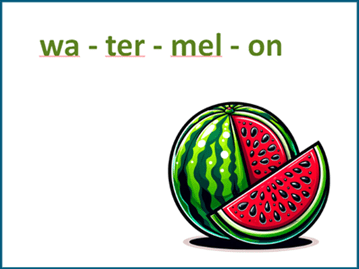What is syllabification?
Syllabification is the process of dividing words into smaller units called syllables. A syllable is a unit of sound that typically contains a vowel sound and may or may not be accompanied by consonant sounds.
Here's how syllabification works:
Identifying vowel sounds: The first step in syllabification is identifying the vowel sounds in a word. Vowels are the letters A, E, I, O, U, and sometimes Y. Each vowel sound usually forms the nucleus of a syllable.
Grouping consonant sounds: Consonant sounds that come before or after a vowel sound are grouped with that vowel to form a syllable. However, some consonant combinations may belong to different syllables depending on the language and pronunciation rules.
Counting syllables: Once you've identified the vowel sounds and grouped the consonants, you can count the number of syllables in the word. Each unit of sound, containing at least one vowel sound, represents one syllable.
For example, let's syllabify the word "watermelon".
"wa-ter-mel-on"
In this word, there are four syllables: "wa," "ter," "mel," and "on."

Why is syllabification important to learn?
Syllabification is important to learn for several reasons:
Reading skills: Understanding syllables helps students break down words into smaller, more manageable parts. This skill is crucial for developing strong reading skills, as it enables students to decode unfamiliar words more easily.
Spelling skills: Syllabification is closely tied to spelling. Knowing how to break words into syllables helps students understand the patterns and structures of words, which in turn improves their spelling abilities.
Vocabulary development: Learning about syllables can enhance children's vocabulary development. When students understand syllables, they can more easily learn new words by recognizing familiar syllable patterns in unfamiliar words. This knowledge allows them to make connections between words and expand their vocabulary more effectively.
Speech and pronunciation: Syllabification can also improve children's speech and pronunciation skills. By learning to identify and produce syllables correctly, students develop clearer articulation and speech patterns. This is particularly important for kids who may struggle with speech difficulties or have accents that differ from the language they are learning.
How can we teach students syllabification?
Here's a step-by-step approach to teach students syllabification
Start with clapping
Begin by clapping out the syllables in simple words. For example, say a word like "cat" and clap once for each syllable: "cat" (clap). Then, move on to words with more syllables like "elephant" and clap three times: "el-e-phant" (clap, clap, clap).
Use visual aids
Visual aids can help reinforce the concept of syllables. You can create flashcards with words on them and draw lines between the syllables to visually represent how the word is broken down. For example, write "butterfly" and draw lines like this: "but-ter-fly."
Play games
Turn syllabification into a game. You can have a syllable scavenger hunt where kids search for objects with a certain number of syllables in their names. You can also play "Syllable Bingo," where kids mark off squares on a bingo card with words of different syllable counts as you call them out.
Sing songs
There are many songs and chants that can help kids understand syllabification. You can create simple tunes or find existing ones online that help kids practice clapping out the syllables in words.
Practice with tongue twisters
Tongue twisters are not only fun but also great for practicing syllabification. Start with simple tongue twisters and gradually move on to more complex ones. Encourage kids to clap out the syllables as they say the tongue twister.
Use everyday examples
Point out syllables in everyday words and phrases. For example, when you're in the kitchen, you can point to objects like "cupcake" and break it down into syllables: "cup-cake."

